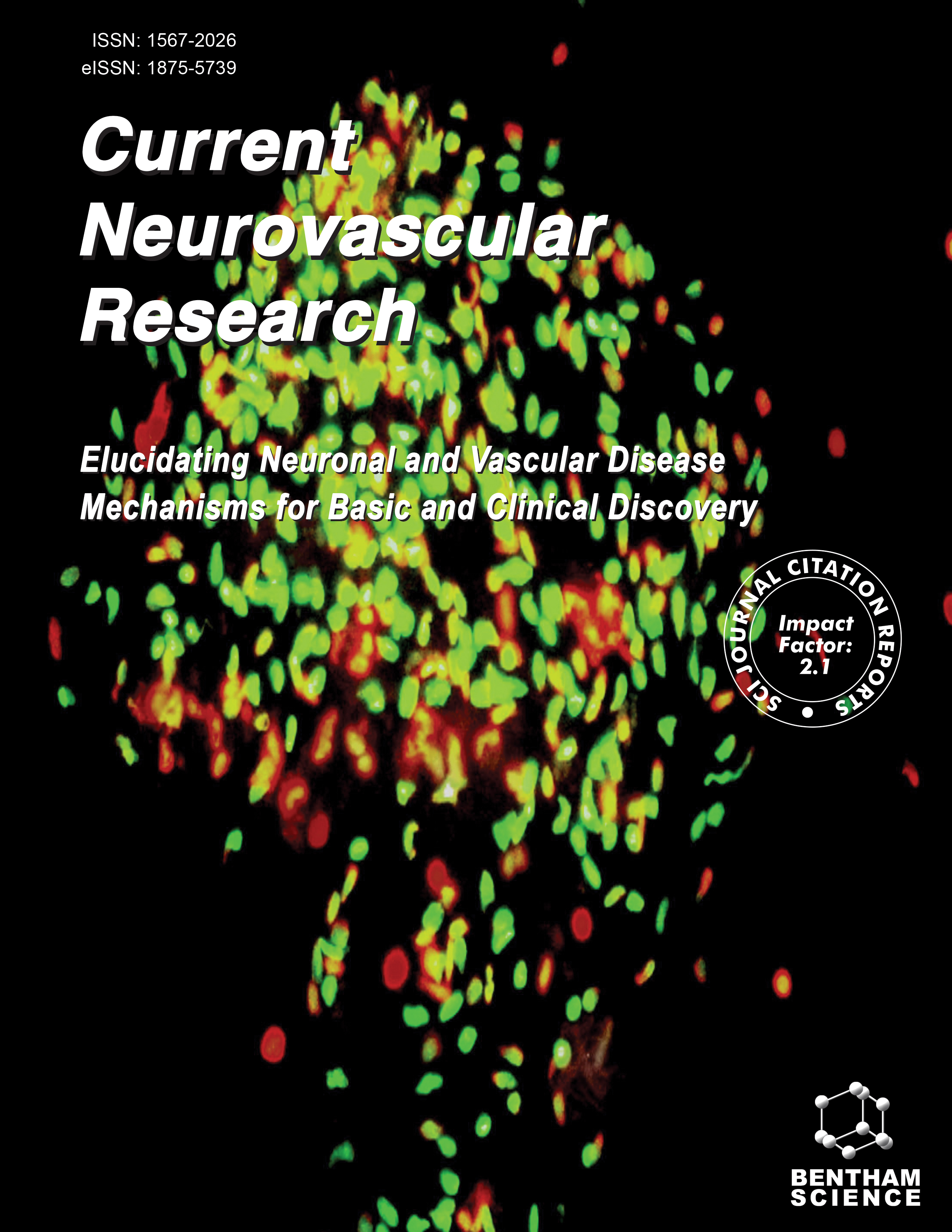- Home
- A-Z Publications
- Current Neurovascular Research
- Previous Issues
- Volume 7, Issue 4, 2010
Current Neurovascular Research - Volume 7, Issue 4, 2010
Volume 7, Issue 4, 2010
-
-
Environmental Enrichment Influences BDNF and NR1 Levels in the Hippocampus and Restores Cognitive Impairment in Chronic Cerebral Hypoperfused Rats
More LessAuthors: Huimin Sun, Junjian Zhang, Lei Zhang, Hui Liu, Hong Zhu and Ying YangAn enriched environment (EE) is beneficial in modifying behaviors, particularly in tasks involving complex cognitive functions. However, the impact of EE on cognitive impairment induced by chronic cerebral hypoperfusion (CCH) has not been studied. We investigated the effects of EE on cognitive impairment caused by CCH and examined whether CCH altered the protein levels of brain-derived neurotrophic factor (BDNF) Read More
-
-
-
Hsp20 Protects Neuroblastoma Cells from Ischemia/Reperfusion Injury by Inhibition of Apoptosis via a Mechanism that Involves the Mitochondrial Pathways
More LessAuthors: Liuwang Zeng, Jieqiong Tan, Zhiping Hu, Wei Lu and Binbin YangHsp20 is a chaperone protein that is highly and constitutively expressed in the brain, cardiac tissue and many other organs. Recently, it is well established that Hsp20 can enhance cardiac function and render cardioprotection. However, the potential benefits of Hsp20 and its phosphorylation form action on ischemic stroke and the underlying mechanism(s) are largely unknown. To investigate whether Hsp20 exerts protective e Read More
-
-
-
Chronic Hypoxia Potentiates Age-Related Oxidative Imbalance in Brain Vessels and Synaptosomes
More LessThis study was aimed to evaluate and compare the effect of chronic hypoxia and aging in the oxidative status of brain vessels and synaptosomes. For this purpose we isolated brain vessels and synaptosomes from 3- and 12-month-old rats subjected to chronic hypoxia (10% O2 for 7 days) or normoxia (21% O2). Several parameters were evaluated: mitochondrial aconitase activity, hydrogen peroxide (H2O2) and malondialdeh Read More
-
-
-
Traumatic Spinal Cord Injury Alters Angiogenic Factors and TGF-Beta1 that may Affect Vascular Recovery
More LessAuthors: Marie-Francoise Ritz, Ursula Graumann, Bertha Gutierrez, Oliver Hausmann and ETraumatic spinal cord injury (SCI) disrupts the blood-spinal cord barrier and reduces the blood supply caused by microvascular changes. Vessel regression and neovascularization have been observed in the course of secondary injury contributing to microvascular remodeling after trauma. Spatio-temporal distribution of blood vessels and modulation of gene expression of several angiogenic factors have been investigated in Read More
-
-
-
Human Platelets Express Authentic CB1 and CB2 Receptors
More LessAuthors: M. V. Catani, V. Gasperi, G. Catanzaro, S. Baldassarri, A. Bertoni, F. Sinigaglia, L. Avigliano and M. MaccarroneIn the last decade, the neurovascular effects exerted by endocannabinoids (eCBs) have attracted growing interest, because they hold the promise to open new avenues of therapeutic intervention against major causes of death in Western society. Several actions of eCBs are mediated by type-1 (CB1) or type-2 (CB2) cannabinoid receptors, yet there is no clear evidence of the presence of these proteins in platelets. To demonstrat Read More
-
-
-
Free Radical Scavenger Edaravone Administration Protects against Tissue Plasminogen Activator Induced Oxidative Stress and Blood Brain Barrier Damage
More LessOne of the therapeutics for acute cerebral ischemia is tissue plasminogen activator (t-PA). Using t-PA after 3 hour time window increases the chances of hemorrhage, involving multiple mechanisms. In order to show possible mechanisms of t-PA toxicity and the effect of the free radical scavenger edaravone, we administered vehicle, plasmin, and t-PA into intact rat cortex, and edaravone intravenously. Plasmin and t-PA Read More
-
-
-
Interleukin-1 Drives Cerebrovascular Inflammation via MAP Kinase-Independent Pathways
More LessAuthors: Peter Thornton, Barry W. McColl, Laura Cooper, Nancy J. Rothwell and Stuart M. AllanCerebrovascular inflammation is triggered by diverse central nervous system (CNS) insults and contributes to disease pathogenesis. The pro-inflammatory cytokine interleukin (IL)-1 is central to this cerebrovascular inflammatory response and understanding the underlying signalling mechanisms of IL-1 actions in brain endothelium may provide therapeutic targets for disease intervention. For the first time, we compar Read More
-
-
-
Protein-Energy Malnutrition Alters Hippocampal Plasticity-Associated Protein Expression following Global Ischemia in the Gerbil
More LessPreviously it has been demonstrated that protein-energy malnutrition (PEM) impairs habituation in the open field test following global ischemia. The present study examined the hypothesis that PEM exerts some of its deleterious effects on functional outcome by altering the post-ischemic expression of the plasticity-associated genes brain-derived neurotrophic factor (BDNF), its receptor tropomyosin-related kinase B (trkB), Read More
-
Volumes & issues
-
Volume 21 (2024)
-
Volume 20 (2023)
-
Volume 19 (2022)
-
Volume 18 (2021)
-
Volume 17 (2020)
-
Volume 16 (2019)
-
Volume 15 (2018)
-
Volume 14 (2017)
-
Volume 13 (2016)
-
Volume 12 (2015)
-
Volume 11 (2014)
-
Volume 10 (2013)
-
Volume 9 (2012)
-
Volume 8 (2011)
-
Volume 7 (2010)
-
Volume 6 (2009)
-
Volume 5 (2008)
-
Volume 4 (2007)
-
Volume 3 (2006)
-
Volume 2 (2005)
-
Volume 1 (2004)
Most Read This Month
Article
content/journals/cnr
Journal
10
5
false
en


